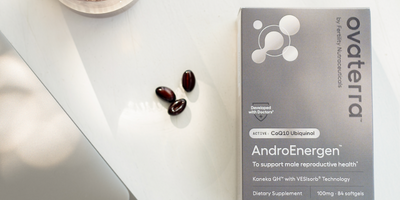Thinking about a new addition to your family? Some women get pregnant as soon as they start trying, but others find that getting pregnant takes a bit more work than the “birds and bees” talk would imply.
To get pregnant, you need to know about one of the most important processes in the reproductive cycle: ovulation. Tracking ovulation and knowing when you are fertile is the first step on this journey, but when should you start tracking ovulation? Let’s find out.
When do you ovulate?
Ovulation is the process in which your body releases an egg from one of your ovaries. The ovulated egg enters the fallopian tube, where it will wait for 12 to 24 hours to be fertilized by sperm. In an average 28-day cycle, ovulation occurs about 14 days before your next period. It can range between ten and 16 days before.
Keep in mind that women do not run on the same clock. We have different cycle lengths, can have health conditions like polycystic ovary syndrome, and can have irregular periods. All of this contribute to your unique timing of ovulation.
Since there isn't a one-size-fits-all answer about exactly when you ovulate, it is important to know when you should start tracking ovulation and what kind of ovulation predictor tests are available to help you do so.
Read on to further your knowledge about getting pregnant with the help of ovulation testing.
Why should you test for ovulation?
Testing for ovulation may help you increase your chances of conception by allowing you to know when you are most fertile or when your “fertile window” occurs. Your best chances of getting pregnant are between a few days before ovulation and about a day after ovulation.
Testing for ovulation helps pinpoint the time in which your body needs sperm to enter the fallopian tube to fertilize the ovulated egg. In other words, the time in which you and your partner better get busy.
What kinds of ovulation tests are there?
There are many ways to track ovulation. These tests can be done at home through kits purchased online, at the store, or by a medical professional. Let’s talk about your options.
BBT Test
A Basal Body Temperature (BBT) test is one way to track your ovulation. This method uses changes in your body temperature to predict when you will ovulate. Your body temperature rises slightly when it is preparing for a possible pregnancy. This change is about a half a degree or less.
To use this method, you would need to record your BBT every day for a few menstrual cycles to look for a pattern in your temperature. One drawback of this testing method is that your body temperature can change for many reasons - like illnesses, stress or sleep disruptions. You can use an algorithm-driven BBT method like Tempdrop that removes these random fluctuations for easier interpretation, or consider using these methods with others to increase your chances of pregnancy.
Get to know your cervical mucus
Observing the changes in your cervical mucus is another way to track when you are ovulating. Before ovulating, your mucus will be clear and have a similar look and texture to an egg white. After ovulation, your mucus becomes thicker and less clear.
You can check and keep records of your cervical mucus manually, or use a cervical mucus-based fertility tracker called kegg. This is an advanced - and easier - way to measure and analyze your cervical mucus to know when you should have sex to get pregnant.
Bonus: You can use the kegg to do kegel exercises to help strengthen your pelvic floor, which may help after delivering a baby.
Hormone tests
Hormone tests for ovulation can be done with an at-home ovulation testing kit. Ovulation test strips analyze your urine for increased luteinizing hormone (LH) and PdG (the urine metabolite of progesterone) levels.
Your LH levels will rise about one to two days before ovulation. Your PdG levels rise just after ovulation, reflecting the rise in progesterone to facilitate implantation. Simple urine tests for these hormones can let you know whether or not you are ovulating.
These tests typically have numerous strips to test on many days during each menstruation cycle. Hormone-based ovulation tests are about 99 percent accurate when used appropriately, so there is less chance of a false positive when used as described.
What is the difference between various ovulation tests?
Each type of ovulation tests have pros and cons, and there isn’t a “one size fits all.” A handful of factors influence which ovulation test is the right fit for you, and you may want to use more than one ovulation tracking methods because doing so could increase accuracy and your chances of getting pregnant.
You can even try one method and either add another or a new one as you figure out your most fertile days.
How to determine which day to start testing
Women have different menstruation cycles, so tracking your personal cycle is vital when using ovulation testing to get pregnant. Knowing your cycle is necessary for you to understand which day of your cycle to start testing.
Your first day is the first day of your period (not spotting, full flow). Then you will need to know how many days until you start your period again. That will be the number of days in your menstrual cycle.
Then, if you are using ovulation test strips, you start testing for ovulation a few days before you expect to ovulate. There is some trial and error involved, but for women with a 28-day cycle, you would assume ovulation roughly 14 days before your next period. As you test more, you will get a better sense of when you should start testing in the next cycle.
If you are using the BBT method or cervical mucus method, you measure your BBT or check your cervical mucus throughout your cycle.
When is the best time of day to use an ovulation test kit?
Generally, ovulation testing kits recommend that you use the test stick first thing in the morning. This is because you have been “fasting” while you sleep, so your urine is concentrated and more likely to provide accurate results.
For those of you using the BBT method, the best time of day to use the BBT thermometer is also in the morning, as soon as you get up and before doing anything else. Cervical mucus method, on the other hand, can be used at any time of day.
When to start ovulation testing with irregular cycles
If you know that your cycle is irregular and doesn’t match the typical 28-day cycle, you will want to start ovulation tests as soon as you decide you want to conceive.
Since your cycles may be unpredictable or longer/shorter than the “normal” range, it will be difficult to estimate when to start your test in your cycle at first.
If you start testing a few days after your period ends and continue until you get your next period, you will have a better chance of getting a positive result for ovulation. Some tests come with 15 testing strips, which should offer you enough to get through your cycle.
Positive ovulation test: What to do next
After getting a positive ovulation test, you and your partner should get to work. You will want to have intercourse as soon as possible. Sperm can survive in the fallopian tube for about five days, but an egg will only wait to be fertilized for 12 to 24 hours before your “fertility window” closes - so it’s best to have sperm in place, waiting, when ovulation occurs, likely in the next day or two.
Ovulation test is negative: Was everything done right?
You may not get it right in your first cycle. Here are some things to check if you keep getting a negative result.
- Did you follow the test kit’s directions?
- Are you starting to take your tests a few days before your anticipated ovulation day?
- Have you tested for many days in a row?
- Are you using other methods (cervical mucus, for example) to predict when ovulation will occur?
What causes negative ovulation tests?
There are several reasons you may get a negative ovulation test result:
- The increase in the luteinizing hormone is short-lived, so you may have missed the window.
- You may have started testing too early if your cycles are longer than average.
- You may have taken the test incorrectly.
- You may have a hormonal problem that prevents ovulation from happening.
Are ovulation test results 100% accurate?
Not all ovulation tests have the same accuracy rate. Generally speaking, though, their accuracy is about 90% and above. This also depends largely on whether or not you are following proper procedures and your medical factors, like PCOS, that can lead to an inaccurate test.
Women in their 40s may also find it difficult to catch ovulation with LH test strips, because LH levels can stay high throughout the cycle once you enter your late 30s and 40s. Here's our guide to selecting ovulation tests, based on 5 factors about you.
How to take an ovulation test
Ovulation predictor kits are used differently. Depending on what type of test you are taking, carefully read the directions on how to appropriately take the test you have chosen.
Tips on how to get the most accurate results for your ovulation test:
- Read the directions carefully.
- Start tracking your period cycles as soon as you start thinking about getting pregnant. (This will give you time to learn and perfect the method.)
- Know the signs of ovulation (such as changes in cervical mucus or basal body temperature).
- Combine multiple methods of ovulation and fertility tracking.
The bottom line
Tracking your ovulation can be done as soon as you decide to get pregnant or if you have had a difficult time getting pregnant. First, you will need to track your menstrual cycle to estimate when you should ovulate.
Afterward, decide on which method you want to use to detect when you are most fertile during your cycle. Keep in mind that this may take a few menstrual cycles to zero in on when you ovulate.
Remain curious, maintain your overall health, and be mindful when you need to have sexual intercourse to help increase your chances of pregnancy. And reach out if you feel confused or overwhelmed about ovulation tracking. We are with you.











